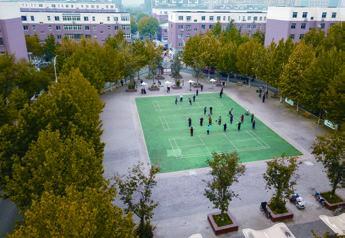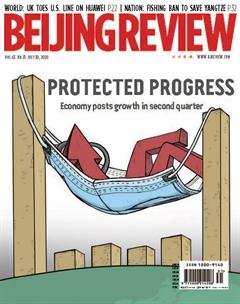Good as New
By Lu Yan

Since the renovation of her community, Li Guizhen, 82, likes sunbathing in the residential yard much more. A large number of flower pots have been added, the lawn has been expanded, and new fitness equipment installed at Anju Community in Qinhuangdao, a coastal city in Hebei Province in north China.
“Our neighborhood has undergone dramatic changes; it is so nice here now,”Li told Beijing-based Economic Daily. Built in the 1990s, Anju Community has 20 residential buildings and is home to over 1,000 people. However, the old community was plagued with aging water supply pipeline and sewage networks, and crumbling pavements.
Two years ago, the community started its renovation as a part of the citys plan to renovate residential areas. Before construction started, residents suggestions were collected as an important reference for renovation. Handrail installation was suggested, and has now become a reality.
“There are a lot of seniors like me in this community who have diffi culty walking. It is much safer for us to have something to hold on to when we enter or exit our buildings,” Li said, recalling that in the past, she had to walk with extreme caution to avoid an accidental fall.
“We want to resolve the problems of each community based on their specific conditions and the requirements of their residents,” Jing Yan, a staff member with the citys housing construction bureau, said.
An urgent need
Renovating apartment doors, windows and building gates was another major endeavor for Anju Community. All windows were upgraded to be energy effi cient, which will keep rooms warm in winter and cool in summer.
Resident Zhao Xiuhong said that they paid only for a part of the window renovation cost, while the rest was covered by government subsidies. People decided which materials they wanted to use according to their specifi c fi nancial situation. “With the subsidy, my family saved 30 percent of the cost for these nice windows,” Zhao said.
More than 330 old residential areas in Qinhuangdao have been renovated, benefi ting over 150,000 households. “The resident satisfaction rate with the result of the renovation plan is over 90 percent, according to our research,” Jing said. “I believe the rate will go further up as the city fi nishes renovating all old residential areas by the end of the year.”
Qinhuangdao, one of 15 cities to pilot the national policy on renovating aging urban residential areas, has been working on the project since 2016. This years government work report highlighted that China will strengthen a new type of urbanization. Toward this end, the renovation of old urban residential communities will play a crucial part.
In old communities, facilities like water supply, drainage, sewage, electricity, gas, heat, communications and cable TV have aged or cant meet increasing resident demand; there is a lack of supporting public services such as elderly care, childcare and property management; elevators are needed as the population in these communities ages.
In July, the State Council, Chinas cabinet, released guidelines stressing that the renovation in all the aging urban residential communities should be completed by the end of the 14th Five-Year Plan (2021-25) period.
Major renovation will be done in communities built before 2000 to improve supporting infrastructure, the environment and the quality of public services, according to Huang Yan, Vice Minister of Housing and Urban-Rural Development, the countrys top housing regulator.
Huang said there are about 220,000 such communities across China, which are home to 39 million households. This year, renovation of 39,000 urban residential communities will begin, benefi ting about 7 million households.
According to the guidelines, the renovation program will be divided into three types based on residents requirements and actual community conditions. The fi rst kind involves renovation that ensures the basic living and safety of residents, such as repairing infrastructure, walls and stairways.
The second mainly encompasses environment improvements, energy-saving reconstruction of buildings and elevator installation, which will greatly improve the communities quality of life.
The third is a step further, which in-cludes the construction of service and healthcare facilities, such as clinics, kindergartens, cafeterias, convenience stores and courier service stations.
From the bottom up
While the plan has been applauded in general, some people are still reluctant to participate.

For example, a decision on whether elevators should be installed at a building in a community in Shanghai took 20 rounds of negotiation meetings. “Residents living on higher floors supported the decision, while some of those living on lower levels disagreed. They said it was unnecessary and the elevator, which would be attached to the external walls of the building, might block the sunshine,” Hou Xiufang, the residential assistant of the building, explained. In the end, all residents agreed on a plan to split the costs and the elevator was installed.
Huang said the decision-making process in each community is from the bottom up, and residents have the fi nal say on whether their community should be renovated.
Upgraded plans
The current national plan for renovating residential communities is similar to plans carried out in the past, but it is more comprehensive. Efforts will be made to mobilize citizens to participate in the work and enhance long-term neighborhood management mechanisms, Huang said. Moreover, the plan encourages more parties to invest in renovation projects.
In addition to resident payments, funding for the projects will come from the government and society at large, Huang said.
Two banks—China Development Bank, a major policy bank, and China Construction Bank, one of the countrys largest stateowned commercial banks—will provide 436 billion yuan ($62.25 billion) in loans, according to the Ministry of Housing and UrbanRural Development.
Liu Shihu, an official with the National Development and Reform Commission, said renovation projects play an important role in improving peoples livelihood, and stabilizing economic growth because they also boost the development of multiple relevant industries and motivate residents to have their apartments redecorated and purchase new home appliances.

